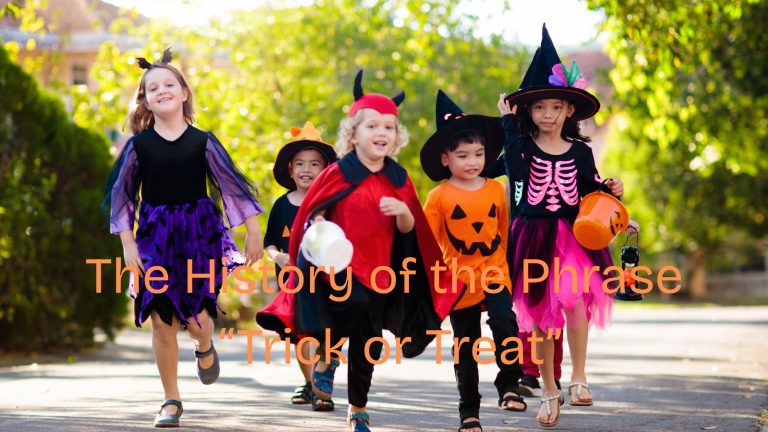
The Fascinating History of Halloween: From Ancient Origins to Modern Celebrations
Halloween is one of the most beloved and widely celebrated holidays in many parts of the world. Each year on October 31st, children and adults alike dress up in costumes, carve pumpkins into jack-o’-lanterns, and go door-to-door trick-or-treating. But how did this spooky and festive tradition begin? The history of Halloween is a tapestry woven from ancient religious practices, folklore, and cultural adaptations spanning centuries. In this blog post, we’ll explore the origins of Halloween, its evolution over time, and how it became the holiday we know and love today.
Origins of Halloween: Samhain and Celtic Traditions
The history of Halloween can be traced back over 2,000 years to the ancient Celtic festival of Samhain (pronounced “sow-in”). Samhain was celebrated by the Celts, who lived in what is now Ireland, the United Kingdom, and northern France. This festival marked the end of the harvest season and the beginning of winter, which was often associated with death. The Celts believed that on the night of October 31st, the boundary between the worlds of the living and the dead became blurred, allowing the spirits of the dead to return to Earth.
During Samhain, the Celts would light large bonfires, offer sacrifices, and wear costumes—usually made from animal heads and skins—in an attempt to ward off roaming spirits. They believed that by wearing these disguises, they could blend in with the supernatural entities or avoid being recognized by evil spirits. These traditions, rooted in both a reverence for nature and a fear of the supernatural, would eventually serve as the foundation for many of Halloween’s customs today.
Roman Influence: The Festivals of Feralia and Pomona
As the Roman Empire expanded, it absorbed many of the Celtic lands, and with that, Roman customs began to merge with Celtic traditions. By the time the Romans had conquered much of the Celtic territory in the first century AD, two Roman festivals were combined with the Celtic festival of Samhain: Feralia and Pomona.
Feralia was a Roman festival that commemorated the passing of the dead, aligning well with Samhain’s themes of death and the afterlife. The second festival, Pomona, honored the Roman goddess of fruit and trees. Pomona’s symbol was the apple, and the incorporation of this fruit into the Samhain celebration likely led to the Halloween tradition of bobbing for apples, which remains a popular game today.
Christianity and the Creation of All Saints’ Day
By the 7th century, Christianity had spread throughout Celtic lands. As with many pagan festivals, the Christian Church sought to transform or Christianize local traditions. In an attempt to replace the pagan festival of Samhain with a church-sanctioned holiday, Pope Boniface IV established All Saints’ Day (also known as All Hallows’ Day) on November 1st. This day was meant to honor saints and martyrs of the Christian faith, and it was preceded by All Hallows’ Eve on October 31st—the precursor to Halloween. Eventually, All Hallows’ Eve was shortened to Halloween.
Later, in the 9th century, the church also established All Souls’ Day on November 2nd to honor all deceased Christians. The customs of All Saints’ Day and All Souls’ Day, with their themes of honoring the dead and visiting graveyards, overlapped with existing Samhain traditions, further embedding Halloween’s association with death, the supernatural, and spirits.
Medieval Halloween Traditions: Mumming and Souling
In medieval times, Halloween traditions continued to evolve, particularly in England, Scotland, and Ireland. A key practice during this period was mumming or guising—a precursor to modern-day trick-or-treating. Groups of people would dress in costumes, often as ghosts or spirits, and go door-to-door performing songs, reciting verses, or enacting short plays in exchange for food or money.
Another related tradition was souling, which took place on All Souls’ Day. Poor people would go house to house offering prayers for the dead in exchange for food, particularly soul cakes. These small, round cakes were often marked with a cross and given as alms. In return, the recipients would promise to pray for the souls of the dead relatives of the household, aiding them on their journey through purgatory. Both mumming and souling contributed to the development of Halloween’s trick-or-treating custom.
The Rise of Witchcraft and Superstition
During the late medieval period and into the Renaissance, European society experienced a growing fear of witches, sorcery, and the supernatural. This fear was partly driven by the Church, which, through the Inquisition, sought to root out heresy and witchcraft. As a result, witches became a central figure in Halloween folklore, symbolizing the evil forces that were believed to roam the Earth during the festival.
Stories of witches riding broomsticks, casting spells, and transforming into animals (particularly black cats) became common Halloween themes. The association between witches and Halloween has persisted into modern times, with witches being one of the most popular Halloween costumes and symbols.
Halloween in America: Immigration and Adaptation
Halloween as we know it today began to take shape in the United States during the 19th century, largely due to the influx of Irish and Scottish immigrants who brought their Halloween customs with them. The mid-19th century, particularly during the Irish Potato Famine of the 1840s, saw a large wave of Irish immigrants arriving in America. They brought with them their traditions of guising, carving turnips (which would later evolve into pumpkin carving), and celebrating the night of October 31st.
Initially, Halloween was primarily celebrated in the immigrant communities of the United States, but by the late 19th and early 20th centuries, it began to spread throughout the wider population. American Halloween celebrations were influenced by a variety of traditions, including those of Native Americans and African Americans, who added their own cultural elements to the holiday. Over time, the focus of Halloween shifted away from its religious and supernatural origins and became more of a community-centered holiday, especially for children.
The Birth of Trick-or-Treating
One of the most iconic aspects of modern Halloween, trick-or-treating, became popular in the United States during the early 20th century, but its roots can be traced back to the medieval practices of mumming and souling. In the early 1900s, American children began dressing in costumes and going from house to house, asking for treats such as candy, fruit, or coins. If homeowners did not provide treats, children might play a “trick” on them, often involving harmless pranks like soaping windows or knocking on doors and running away.
The practice of trick-or-treating gained widespread popularity in the 1920s and 1930s, and by the 1950s, it had become a well-established Halloween tradition in America. The rise of consumer culture during this period also contributed to the commercialization of Halloween, with companies producing candy, costumes, and decorations specifically for the holiday.
Jack-O’-Lanterns and the Legend of Stingy Jack
One of the most enduring symbols of Halloween is the jack-o’-lantern, a carved pumpkin with a candle inside. The tradition of carving jack-o’-lanterns originated from the Irish practice of carving turnips or potatoes into lanterns. These lanterns were often placed in windows or doorways to ward off evil spirits.
The name jack-o’-lantern comes from an Irish legend about a man named Stingy Jack, who tricked the Devil and was doomed to wander the Earth for eternity, unable to enter either heaven or hell. According to the story, Jack carried a carved-out turnip with a burning coal inside to light his way as he wandered the darkness. When Irish immigrants arrived in America, they found that pumpkins, native to the New World, were larger and easier to carve than turnips, and thus the modern jack-o’-lantern was born.
The Modern Halloween: Costumes, Parties, and Pop Culture
By the mid-20th century, Halloween had evolved into a full-fledged American holiday, with an emphasis on fun, costumes, and community events. Children and adults alike dressed up in a variety of costumes, from spooky figures like ghosts, witches, and vampires to popular characters from movies, television, and books. Halloween parties became a common way to celebrate, featuring games like bobbing for apples, costume contests, and haunted houses.
The influence of pop culture on Halloween cannot be overstated. Throughout the 20th century, Hollywood helped shape modern Halloween through the production of horror films, including classics like Dracula (1931), Frankenstein (1931), and Halloween (1978), which introduced the iconic character Michael Myers. These films, along with countless others in the horror genre, have cemented Halloween’s association with fear, suspense, and the supernatural.
Television specials like It’s the Great Pumpkin, Charlie Brown (1966) and Halloween-themed episodes of popular TV shows further ingrained the holiday into the fabric of American culture. Today, Halloween is one of the most popular holidays in the United States, with millions of people participating in activities ranging from trick-or-treating to attending costume parties, visiting haunted attractions, and watching scary movies.
Global Halloween Celebrations
While Halloween is most strongly associated with the United States, it is celebrated in various forms around the world. In Canada, Halloween traditions closely mirror those of the United States
, with trick-or-treating, costume parties, and haunted houses being common activities. Mexico celebrates Día de los Muertos (Day of the Dead) around the same time as Halloween, although the two holidays have distinct origins. Día de los Muertos is a time to honor and remember deceased loved ones with altars, offerings, and festive parades.
In Ireland and Scotland, where Halloween has its roots, traditional customs such as guising and bonfires are still practiced, though modern elements like pumpkin carving and trick-or-treating have also become popular. In countries like Japan and South Korea, Halloween has gained popularity in recent years, particularly among young people, who enjoy dressing up in elaborate costumes and attending parties.
Conclusion: The Ever-Evolving Spirit of Halloween
Halloween has come a long way from its ancient Celtic origins in the festival of Samhain. Over the centuries, it has absorbed influences from Roman, Christian, and European traditions, evolving into the modern holiday celebrated around the world today. While the religious and spiritual elements of Halloween have diminished over time, its themes of community, creativity, and a little bit of spooky fun remain as strong as ever.
As Halloween continues to grow in popularity and adapt to new cultural trends, it’s clear that the holiday will continue to captivate people of all ages with its unique blend of history, folklore, and modern entertainment. Whether you’re carving a jack-o’-lantern, dressing up in a costume, or simply enjoying the festive spirit, Halloween offers something for everyone to enjoy. So next time October 31st rolls around, remember the ancient traditions that shaped this beloved holiday—and have a spooktacular time!

